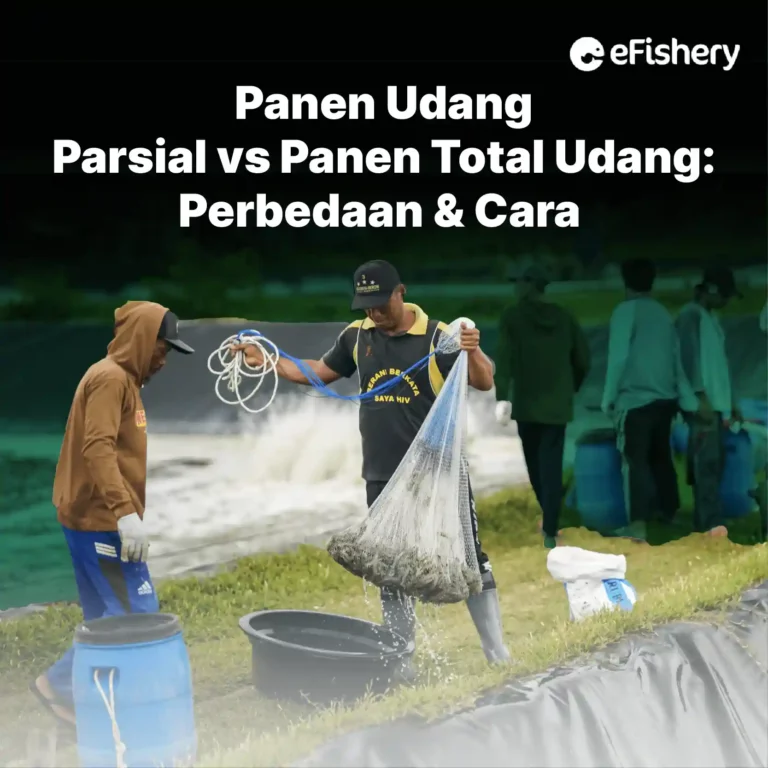Artikel Ini Telah Direview Oleh:

Nabilla Anggi
Magister Budidaya Perairan
Partial shrimp harvest and total shrimp harvest is one of the strategies commonly used by farmers to increase the productivity of shrimp farming. The indicator of increase in shrimp productivity is the increase in the size of the shrimp during sampling and total harvest. In addition to increasing aquaculture productivity, harvesting shrimp is also a solution to other problems. Read more here to find out the difference between total and partial harvests!
What is Partial Harvest and Total Harvest in Shrimp?
Shrimp pond harvest is divided into two types, namely partial harvest and total harvest. Here's the explanation:
Definition of Partial Harvest in Shrimp
Partial harvest is harvesting some of the shrimp in the pond. Partial harvests are carried out at least 2 times and generally every 2 weeks during the last 2 months of the shrimp rearing period. This has a positive impact on shrimp growth because after partial harvesting, shrimp grow faster and avoid large numbers of sudden deaths.
Definition of Total Harvest in Shrimp
Total harvest is the total or entire harvest of shrimp in ponds at the end of the cultivation cycle. Usually the total harvest is done when the DOC is 90-120. However, it is possible for shrimp to be harvested earlier or later, depending on the shrimp growth rate, market demand, and other factors.
How to Determine Partial Harvest and Total Harvest
Determining harvest time cannot be done arbitrarily because choosing harvest time has an impact on cultivation results. The following are factors that can help you determine when to do a partial harvest and a total harvest.
Technical Factors
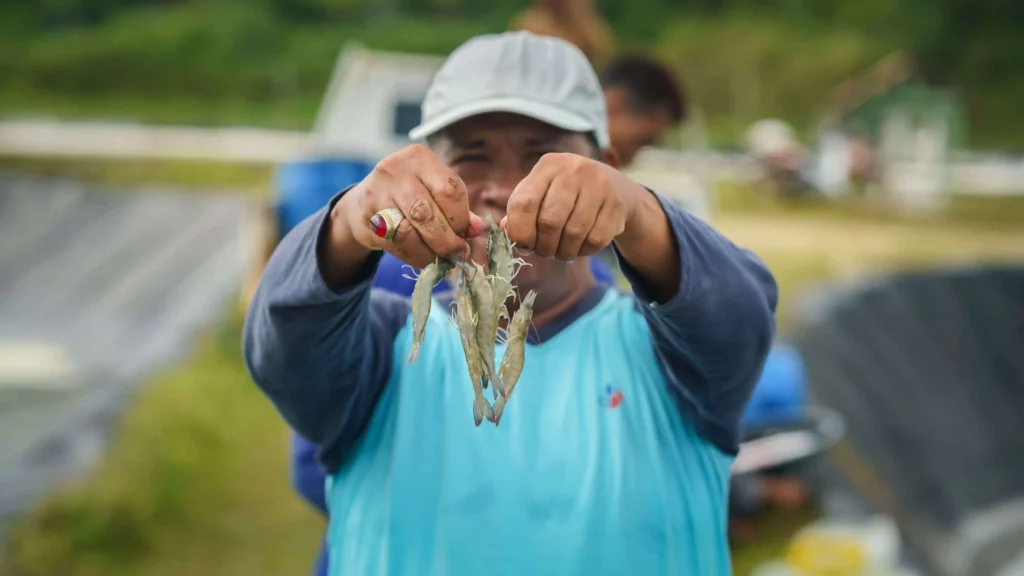
Technical factors are factors in the conditions of your shrimp cultivation which are used as indicators for determining partial harvests. These factors are:
1. Shrimp Biomass
At DOC 60, shrimp biomass is usually close to the carrying capacity of the environment or carrying capacity. carrying capacity is the capacity of an ecosystem to accommodate the population to meet the needs. If the shrimp biomass is too high or is sufficient carrying capacity, then it must be done partial harvest agar carrying capacity and shrimp growth remains optimal.
2. Stocking density
Stocking density is related to shrimp biomass. The higher the stocking density, the faster the biomass approaches carrying capacity, so it is necessary to do a partial harvest to reduce the stocking density in the pond.
3. Water Quality
At the end of the second month of cultivation until the last harvest (fourth month), water quality will decrease due to higher shrimp density and biomass. Stocking densities that are too high will increase organic matter from feed residues and shrimp feces. High organic matter will affect other water qualities such as brightness, pH, nitrite and others, so a partial harvest is needed to maintain optimal water quality.
4. Indication of Disease Attack
Partial harvest is done when indications of disease attack begin to appear, for example shrimp tails that turn red. When this happens, you can immediately reduce stocking density by doing a partial harvest. The goal is to avoid disease transmission to other ponds.
5. Sudden Death
Sudden death can be an indication of several things, such as too high a stocking density resulting in competition, disease and poor water quality. The right step to overcome this is to do a partial harvest.
In addition to these factors, the total harvest can be done when the shrimp have met the desired target weight and size. Usually Farmers will harvest the whole shrimp in the plot at DOC 90-120 or even more.
Business Factors
In addition to considering technical factors, you must also consider business factors when deciding to harvest a partial or total harvest. Business factors are factors that are considered with the aim of generating high profits. If you look at it from a business perspective, you can do partial harvests and total harvests according to market demand and market prices for shrimp.
Usually the price of shrimp appears starting at size 100 because at that size you can already make a profit. Shrimp prices fluctuate, so you also need to consider the right time to harvest shrimp. For example, the price of shrimp in January is high, it could be that in the following month the price of shrimp will drop dramatically. One of the causes of the decline in shrimp prices is the excess supply of shrimp but decreased market demand.
Method & Handling of Partial Harvest and Total Harvest
The harvesting process cannot be done haphazardly, because it will affect the quality of the shrimp. The following are good and correct post-harvest handling and methods.
How to Harvest Partial Shrimp
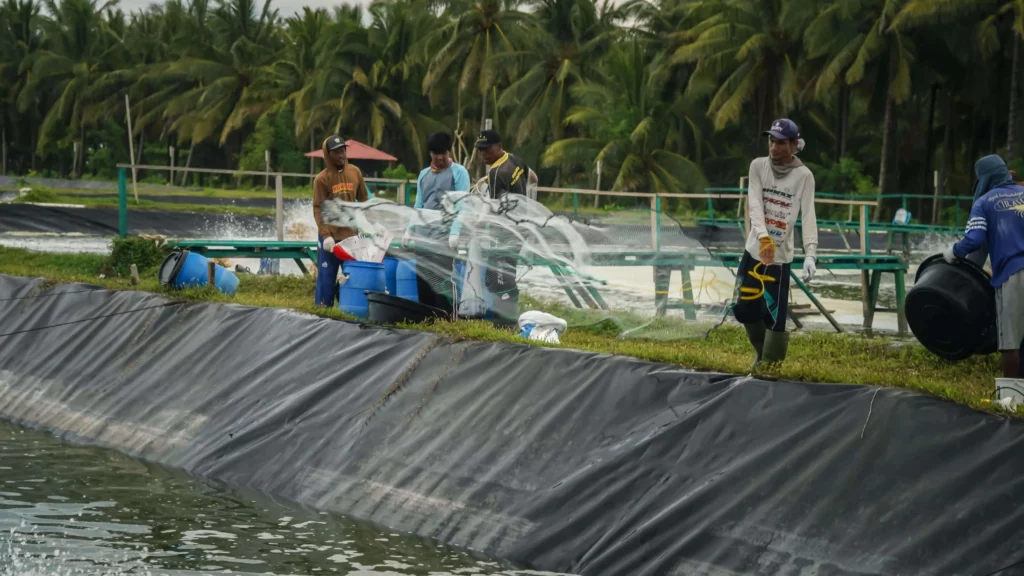
Here's how to safely harvest partial shrimp:
- Do shrimp sampling for harvest with the aim of getting an estimate of the size of the shrimp and determining the selling price. Sampling was carried out 1 (one) hour before feeding.
- Make sure you harvest when the temperature is low or the sun is not too hot or hot. Also make sure there is no silt in the pond, to avoid the mud being stirred up during the harvesting process.
- Sterilize harvesting equipment, especially nets for catching shrimp. Sterilization should be done every time you move ponds or change ponds. The goal is to prevent transmission of diseases that could be carried through pond equipment.
- Turn off the windmills around the location to be harvested to facilitate the harvesting process.
- For partial harvests, usually 20-30% of shrimp population is harvested. If too many shrimp are harvested, it will cause the condition of the pond to shake.
- To lure shrimp together, you can provide feed in the area to be caught.
- Shrimp that has been netted is put into a container to be taken to the sorting site.
How to Harvest Total Shrimp
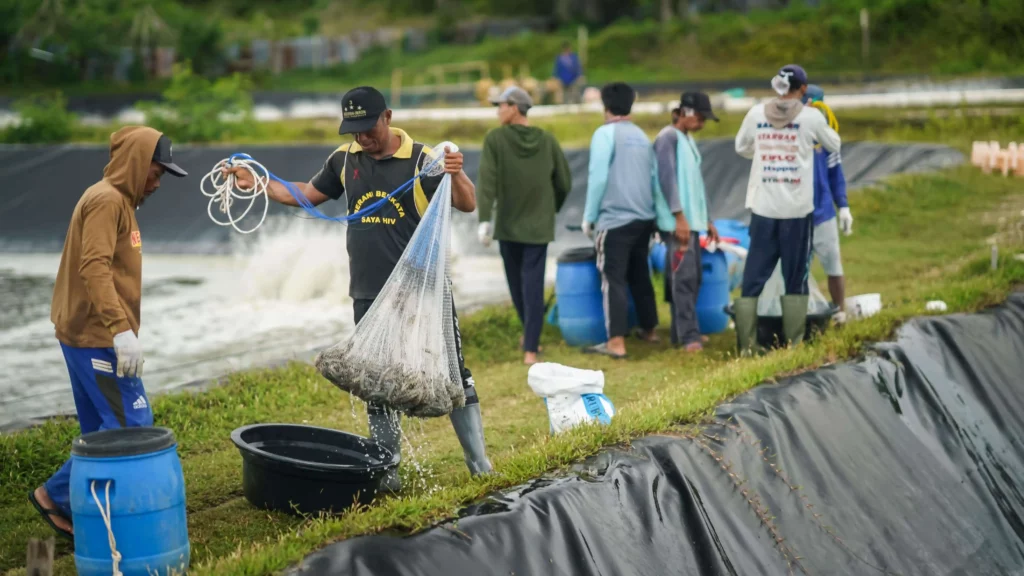
Here's how to harvest the correct total shrimp:
- Do shrimp sampling for harvest with the aim of getting an estimate of the size of the shrimp and determining the selling price.
- Sterilize harvesting equipment, especially nets for catching shrimp. Sterilization should be done every time you move ponds or change ponds. The goal is to prevent transmission of diseases that could be carried through pond equipment.
- Install codend nets in front of the water gates with the aim of preventing shrimp from escaping.
- Open the sluice fitted with the bag net to drain the water.
- Shrimp that exit through the sluice when the water drains will enter the net. You have to guard the nets so that the shrimp don't escape. You can also catch shrimp in the pond when the water depth has reached 20 cm. Along with the shrimp fishing, the pond is drained until the water runs out.
- Shrimp that has been netted is put into a container to be taken to the sorting site.
Partial Post Harvest Handling and Total Harvest
Shrimp is a commodity that is susceptible to damage. That is why the post-harvest handling process is important to ensure food safety (food safety) and maintain the quality of shrimp.
As for the post-harvest handling, the shrimp in the container are put into the cleaning area to be rinsed, then the shrimp are sorted based on size and quality. The sorting process will produce 3 types of shrimp, namely shrimp fresh, soft or molted shrimp shells, and BS (below standard). Criteria for BS shrimp are too small in size and or there are defects in the shrimp's body.
After sorting, the shrimp are weighed and put into a container filled with bulk ice at a ratio of 1:1 with a layered and stacked arrangement (es-shrimp-es-shrimp-ice). The goal is to keep the shrimp fresh and not perishable.
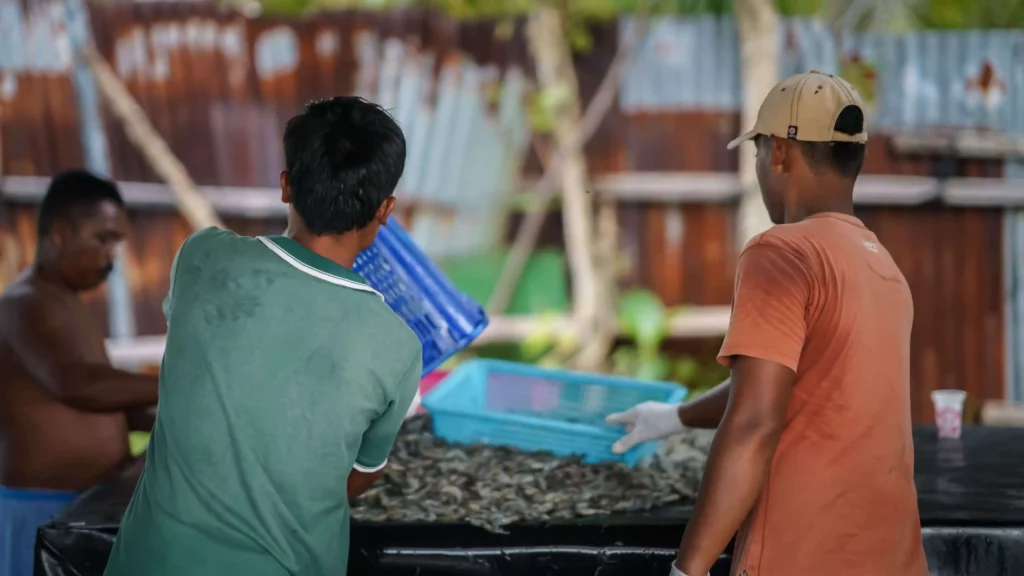
Post-harvest handling that can be done the day after the partial harvest is siphon. The siphon or siphoning process aims to remove dead shrimp due to the harvesting process.
Biasanya, setelah panen parsial, udang mengalami stres sehingga nafsu makan menurun, namun kondisi ini tidak berlangsung lama. Hal yang bisa dilakukan adalah pemuasaan udang satu kali di jam pakan berikutnya. Gunanya untuk menghindari pakan yang terbuang sia-sia.
You also have to be extra vigilant in controlling post-harvest water quality conditions so that water quality remains optimal. You also need to routinely control anco to make sure your shrimp appetite has improved.
After the total harvest is complete, you can carry out a cultivation evaluation and prepare a cultivation plan for the next cycle, starting from draining to filling the pond water.
Things to Look For When Harvesting
Partial shrimp harvesting and total shrimp harvesting greatly affect the condition of the shrimp harvested and the profits obtained. Here are the things that must be considered when harvesting:
- Before harvesting, you should sample independently to ensure the estimated weight, size and quality of the shrimp and determine the harvesting method to be used.
- Find out the condition of shrimp prices in the market to maximize profits.
- Find information on suppliers regarding prices, harvesting mechanisms, and payment processes. This is to prevent losses during the harvest and minimize misunderstandings.
- A few days before harvest, the shrimp are fed with the addition of immunostimulant vitamins and minerals.
- Do not add or reduce pond water for 3 days before harvesting.
- Before harvesting, apply dolomite at a dose of 6-7 ppm, the aim is to harden the shrimp shell. In addition, you can apply CaOH type lime the day before harvest with a dose of 5-20 ppm, the aim is to raise the pH to 9 so that the shrimp don't molt.
- Harvest as soon as possible to avoid molting and low DO shrimp. Maximum harvesting time is 3 hours because more than that the shrimp will be stressed.
Post Harvest Evaluation
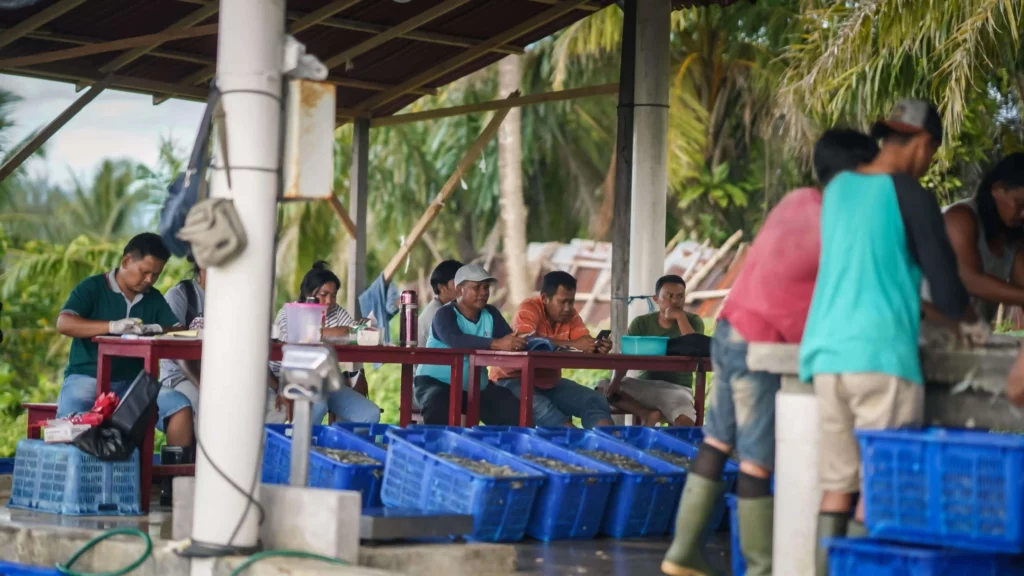
The total shrimp harvest is a marker of the end of the cultivation cycle. In order for the next shrimp farming cycle to be more successful, there are 2 types of evaluation that can be carried out.
Cultivation Evaluation
You can evaluate a number of things that are directly related to how the shrimp farming process went during the last cycle, how the performance of SOP (standard operating procedures) was implemented during the cultivation, and whether it produced better yields or not.
For example, when a partial harvest is carried out due to disease, you can evaluate existing SOPs, such as SOPs for water quality management, feed management, or better selection of fry. This cultivation evaluation is carried out so that the cultivation process in the next cycle runs better and productivity increases.
Market Evaluation
After the total harvest ends, you can evaluate the shrimp harvest based on the dynamics of market prices and the size requested. On average, farmers often increase the size of the shrimp to a larger size, up to size 30. This is done because usually the larger the size, the more expensive the price of the shrimp.
However, there are other farmers who do not only pursue large sizes, because shrimp prices tend to fluctuate and follow market demand. When the size is not big but the price is rising, you can harvest in pursuit of higher profits. For example, when ABW has reached market demand standards (size 60-80), harvesting can be carried out even though the maintenance period has not been 100 days.
However, everything returns to the business decisions of each farmer, which of course goes through profit and loss calculations. To be able to take the right steps, you must always monitor shrimp prices regularly on the market to find out the latest prices.
Make the Right Harvesting Decision by Consulting the Experts
Need Help Regarding Shrimp Cultivation Business?
Fill in your personal data in the following form. Our team will immediately contact you via the number cellphone attached. Make sure the data entered is correct.
The cultivation process is not as easy as the existing theory, for example when determining between partial or total harvest. Sometimes the problems that occur in ponds are different from the information circulating so that it is difficult to make decisions about harvesting.
However, you don't need to worry, because you can consult cultivation issues directly through Cultivation Consultation in app eFarm.
Cultivation Consultation is a feature eFarm provided by eFishery to help you get a solution to the problem of shrimp farming. You can do cultivation consultations which will be answered by experts in their fields. Of course, this feature can be accessed for free!
So what are you waiting for? Consult your cultivation problems right now!

Nabilla Anggi - Magister Budidaya Perairan
Nabilla merupakan lulusan sarjana dan magister budidaya perairan serta memiliki pengalaman di dunia perikanan baik hatchery maupun pembesaran
Questions Regarding Shrimp Harvesting
Partial harvest is the harvesting of some of the shrimp in the pond, while the total harvest is the harvest of the total or all of the shrimp in the pond at the end of the cultivation cycle
Harvest in shrimp farming is divided into two, namely partial harvest and total harvest. Partial harvests are carried out at least 2 times and generally every 2 weeks during the last 2 months of the shrimp rearing period. While the total harvest is done when the DOC is 90-120. However, it is possible for shrimp to be harvested earlier or later, depending on the shrimp growth rate, market demand, and other factors.
Partial harvest is done when the biomass is close carrying capacity, too high stocking densities, decreased water quality, indications of disease attack, and the number of deaths found during siphoning. The goal is for the growth of shrimp to be faster and shrimp to avoid sudden death in large numbers.
The total harvest is carried out when the shrimp have met the weight and size targets desired by the farmers or the demand and market prices are high. The goal is to get the desired profit.
- Adinugoho, M. 2019. Harvesting and Post-Harvesting in Vannamei Shrimp Cultivation. Vannamei Shrimp Cultivation Learning Material Module. 2 p.
- Baiduri, M. A., Andriani, Ridwan and Muslimin. 2022. Partial harvest as a balance between shrimp biomass and media carrying capacity in vannamei shrimp culture in Intensive Ponds. Proceedings of National Semester Politani Pangkep. 3:115- 122.
- BLUPPB Karawang. 2016. Vaname Shrimp Cultivation Techniques (Litopenaeus vannamei). Karawang Aquaculture Production Business Service Center. 4 p.
- BPBAP Situbondo. 2021. Vaname Shrimp Cultivation (Litopenaeus vannamei) in Millennial Shrimp Farming (MSF) Ponds. Ministry of Maritime Affairs and Fisheries Directorate General of Aquaculture Fisheries Situbondo Brackish Water Cultivation Fishery Center. 46 p.
- Iskandar, A., D. Wandanu and Muslim. 2022. Vaname Shrimp (Litopenaeus vannamei) Growing Production Techniques: A Case Study at PT. Goddess of the Sea Aquaculture Garut. Nekton. 2(2): 1-13
